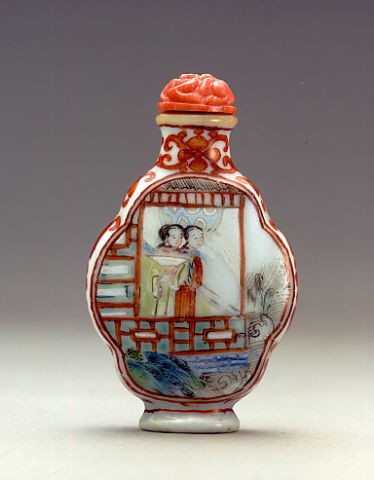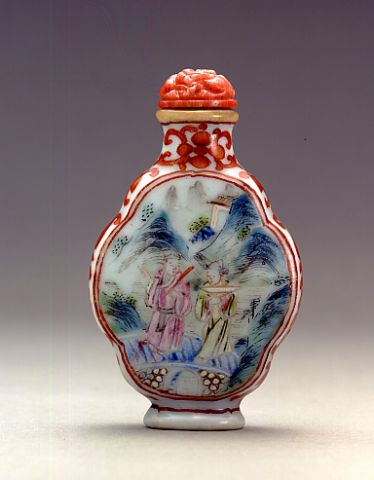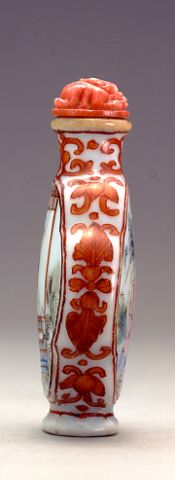


Bottle ID: 00519
PORCELAIN, ENAMELED FAMILLE ROSE, TWO WOMEN & TWO MEN
Date: 1796-1820
Height: 57 mm
Porcelain, hard paste, of quatrefoil form with flattened sides, with everted mouth and splayed foot; decorated in the famille rose palette within vignettes, with on one side two women, one with a fan, waiting on a terrace and looking outwards; the reverse with their two spouses returning across a bridge within a mountainous landscape; the vignettes surrounded and bordered with a design of scolling petals and artemis leaves in overglaze iron-red enamels; the base with an iron-red four character Jiaqing nianzhi mark in seal script and of the period.
Imperial, attributed to the Palace Workshops, Jingde Zhen.
Similar Examples:
Chang Lin-sheng. Snuff Bottles in the Collection of the National Palace Museum, Taipei, Taiwan, 1991, p. 119, no. 83.
Snuff Bottles - The Complete Collection of Treasures of the Palace Museum, Vol. 47, Beijing, 2003, p. 216, no. 327.
Hughes, Michael C. The Blair Bequest - Chinese Snuff Bottles from the Princeton University Art Museum, 2002, p. 174, no. 216.
Provenance:
Asian Art Studio
Michael C. Hughes, LLC
Anonymous New York Private Collection
Sold Christie's London 2002
Exhibited:
Annual Convention ICSBS Toronto, October 2007
A great variety of innovative shapes were produced at the Imperial Kilns in Jingde Zhen towards the end of the Qianlong period, and continued to evolve during the Jiaqing period. These ranged from a flattened globular shape to the flattened quatrefoil form of the Crane example. Often these bottles would have a landscape, floral or garden scene on one side and an imperial poem composed at an earlier date by the Qianlong Emperor on the reverse although this practice was discontinued after his death in 1799. An exciting combination of famille rose enameling, iron-red enamelling and gilding illustrated the potters' skills. The archival records show that around 1790 porcelain snuff bottles were given one at a time as gifts to those in the Palace and to visiting foreign envoys. Large numbers of Imperially marked bottles were made for this purpose during the Jiaqing period.
< Back to full list
 English
English 中文
中文